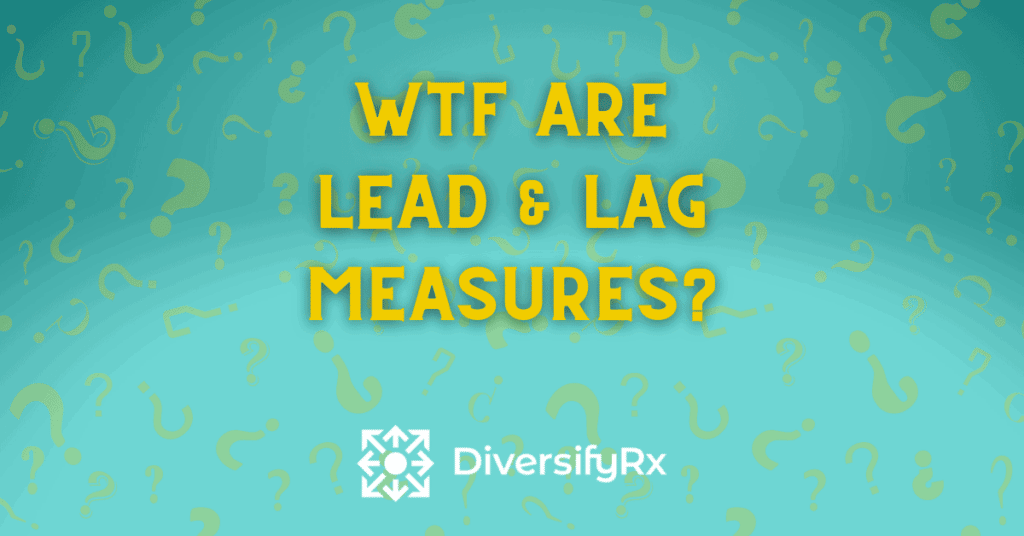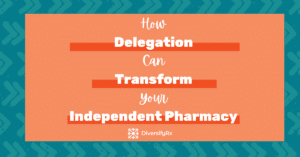Going beyond KPIs and into actionable lead and lag measures.
Let’s get real. It’s no secret that pharmacy owners and their employees work better together when company goals are crystal clear. A thriving pharmacy sets goals, identifies critical KPIs, and keeps track of successes and failures.
Because the pharmacy industry is such a fast-paced business, it’s easy to get caught up in the day-to-day drama, concerns, or that day’s shiny object. This means it’s easy to forget about following up on last month’s goals.
In a previous article, we talked about 3 critical KPIs to help turn your pharmacy into a profit machine. As you recall, KPI’s are documented measurable objectives and provide insight into how the business is doing. KPIs help your pharmacy grow strategically by helping you focus on the most important outcomes.
By aligning your team around the lead and lag measures that support your KPIs, you can achieve positive results in the fastest time possible. Because of this synergy, every pharmacy owner should know what lead and lag measures are and how to use them. Lead and lag measures help you break down your goals into actionable activities that can be tracked, measured, and reported. We have all heard the business wisdom: What gets measured improves and what gets reported on improves exponentially.
What Are Lead And Lag Measures?
Data is useless unless you understand the action around each data point. Lead and lag measures help you to understand which efforts are successful at producing a specific result. Lead measures function as early warning systems to let you know if you are on the right track. While lag measures let you know if you were focusing on the correct activity to get the results you were looking for.
Let’s look at an easy real-world example.
Goal: Lose weight for a big vacation
Sample Lead Measures: number of exercises per week, number of carbs eaten each day.
Sample Lag Measures: number of pounds lost each week.
Lead measures are the tracking of the activities that we think will produce the result we want. Lag measures are the outcomes our actions did have. If you hit your lead measures for every goal, then one would expect the produced results to move in the right direction. However, that is not a guarantee. You need to pair a lag measure with each lead measure to ensure you are tracking the right activities.
Here’s a pharmacy example.
KPI Goal: Increase new patients
Sample Lead Measures: number of doctor office visits per week
Sample Lag Measure: number of incoming patient transfers, number of new patients
The overall goal for this pharmacy is to increase new patients. The pharmacy owner assumes that visiting doctors regularly, every week, will get them more new patients. They set a goal of 5 offices a week.
If they visit 7 a week for 3 weeks, chances are good they will hit their new patient number. The lead measure is looking good. However, if they only visit 1 a week, it is unlikely they will hit their number as the work to produce the outcome is not being performed. While we always want a linear correlation between lead and lag measures (i.e., more doctor visits equals more new patients), it doesn’t always work out this way. If our assumptions were always correct, we would never go wrong. Sometimes we think an activity will produce a result, and yet it doesn’t. This is why tracking is so important to figure out what does work and put more energy into that.
Deeper Dive Into Measures
Noteworthy: these measures are also referred widely as indicators, numbers, drivers, or critical values. Today we’re referring to them as measures.
Lead Measure – Influence Future Performance
Leading measures help predict future results. They can indicate if your performance is likely to achieve your goal or not. Lead measures are typically the day-to-day activities that could potentially produce the lag measures (the goal you’re trying to achieve).
I suggest using lead measures in your employee performance tracking and bonuses. Lead measures are often the side of the equation that is wholly within the control of the employee. Your employees may not be able to control how many people sign up for sync, but they can definitely control how many people they ask.
Lag Measure – Analyze Past Performance
Lag measures are indicators that help measure the goals you want to accomplish and help quickly identify and collect results. It can tell you if you’ve achieved the goal by reporting past results or what’s already happened.
Using lag measures can help you evaluate performance, progress, and when you’ve reached success for a goal, you wanted to achieve. Some lag measures are a good fit for employee performance plans. If a goal can be achieved in a month or less, consider using it to reward employees. When outcomes take longer than a month, they may not be a good fit for regular employees as they need more frequent feedback. Long-term goals are typically for owners and top-level managers.
Choose Your Lag And Lead Measures
Now that we’ve gone over what lead and lag measures are, it’s time for you to define your own. Who else is excited?! Ok, you’re probably not as enthusiastic as I am…
Grab your favorite notebook and pen, and jot down several goals you’d like to achieve, and start to define your pharmacy’s most important KPIs. Don’t forget to talk to your team about issues, areas of improvement, or goals. The more involved your team is, the faster change will happen and the quicker you will reach your goals.
First, think about the activities you predict should happen in order to achieve those goals. Then determine which lead measures you’ll need to analyze and watch to help get you there. Lead measures are not an exact science. They are the activities that you “think” will get you to your goal. I suggest having a brainstorming session on your own and with your team. Then whittle down the ideas to 1-3 that you think will have the most significant impact on your goals. Lastly, you will want to come up with a list of lag measures for these same goals.
Change Your Measures As Your Pharmacy Changes
I’m preaching to the choir here, I know, but remember… things (people, processes, products, offerings, etc.) in pharmacy change frequently and rarely stay the same for long.
The business needs and focus will change over time, and so will your KPI’s and Measurables. Change the measurables when things change in your pharmacy or when you see, feel, or know things need to change. Right now, you might be focusing on the number of patients on your Win-Win report from FDSAmplicare you can get changed during open enrollment. That won’t be your goal in 6 months.
Keep Track And Stay Accountable
It’s one thing to jot down ideas, discuss them as a team, and set companywide goals.
And it’s another to keep track of them and make sure everyone stays accountable, even you.
It’s easy to talk about what to measure and how, but it’s harder to stay accountable and keep track of things consistently.
How do you plan to keep yourself accountable? If you don’t have a support system for your pharmacy, then feel free to leverage DiversifyRx and the badass pharmacy owners in our world. Post your goals and what you need help with. You will be amazed at the support you will receive.
The lead and lag measures will help keep you and your team focused on the goals and help increase your overall success rate, not to mention your profits!
To learn more tips and strategies to help your pharmacy grow and become more successful, be sure to join DiversifyRx’s private Facebook Group.


















